Sayfo
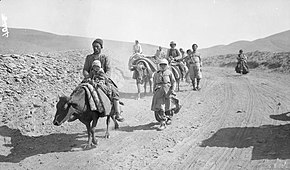
TheSayfo(Syriac:ܣܲܝܦܵܐ,lit. 'sword'), also known as theSeyfoor theAssyrian genocide,was the mass murder anddeportationofAssyrian/Syriac Christiansin southeastern Anatolia and Persia'sAzerbaijan provincebyOttoman forcesand someKurdish tribesduringWorld War I.
The Assyrians were divided into mutually antagonistic churches, including theSyriac Orthodox Church,theAssyrian Church of the East,and theChaldean Catholic Church.Before World War I, they lived in mountainous and remote areas of theOttoman Empire,some of which were effectivelystateless.The empire's nineteenth-century centralization efforts led to increased violence and danger for the Assyrians.
Mass killing of Assyrian civilians began during theOttoman occupation of Azerbaijanfrom January to May 1915, during which massacres were committed by Ottoman forces and pro-Ottoman Kurds. InBitlis province,Ottoman troops returning from Persia joined local Kurdish tribes to massacre the local Christian population (ArmeniansandAssyrians).Ottoman forces and Kurds attackedthe Assyrian tribes ofHakkariin mid-1915, driving them out by September despite the tribes mounting a coordinated military defense. GovernorMehmed Reshidinitiated a genocide of all of the Christian communities inDiyarbekir province,including Syriac Christians, facing only sporadic armed resistance in some parts ofTur Abdin.Ottoman Assyrians living farther south, in present-day Iraq and Syria, were not targeted in the genocide.
The Sayfo occurred concurrently with and was closely related to theArmenian genocide,although the Sayfo is considered to have been less systematic. Local actors played a larger role than theOttoman government,but the latter also ordered attacks on certain Assyrians. Motives for killing included a perceived lack of loyalty among some Assyrian communities to the Ottoman Empire and the desire to appropriate their land. At the 1919Paris Peace Conference,the Assyro-Chaldean delegation said that its losses were 250,000, about half the prewar population. The accuracy of this figure is unknown. They later revised their estimate to 275,000 dead at theLausanne Conferencein 1923. The Sayfo is less studied than the Armenian genocide. Efforts to have it recognized as a genocide began during the 1990s, spearheaded by theAssyrian diaspora.Although several countries acknowledge that Assyrians in the Ottoman Empire were victims of a genocide, this assertion is rejected by the Turkish government.
Terminology
[edit]There is no universally accepted translation in English for theendonymSuryoyoorSuryoye.The choice of which term to use, such asAssyrian,Syriac,Aramean,andChaldean,is often determined by political alignment.[1][2][3]TheChurch of the Eastwas the first to adopt an identity derived from ancientAssyria.TheSyriac Orthodox Churchhas officially rejected the use ofAssyrianin favor ofSyriansince 1952, although not all Syriac Orthodox reject Assyrian identity.[4][5]
Since theOttoman Empirewas organized by religion, Ottoman officials referred to populations by their religious affiliation rather than ethnicity. Therefore, according to historianDavid Gaunt,"speaking of an 'Assyrian Genocide' is anachronistic".[6]InNeo-Aramaic,the languages historically spoken by Assyrians, it has been known since 1915 asSayfoorSeyfo(ܣܝܦܐ,lit. 'sword'), which, since the tenth century, has also meant 'extermination' or 'extinction'.[7][8]Other terms used by some Assyrians includenakba(Arabic for 'catastrophe') andfirman(Turkish for 'order', as Assyrians believed that they were killed according to an official decree).[8]
Background
[edit]The people now calledAssyrian,Chaldean, or Aramean are native toUpper Mesopotamiaand historically spokeAramaicvarieties, and their ancestors converted to Christianity in the first centuries CE. The first majorschisminSyriac Christianitydates to 410, when Christians in theSasanian EmpireformedtheChurch of the Eastto distinguish themselves from the official religion of theRoman Empire.[9]TheWest Syriac church,later the Syriac Orthodox Church, was persecuted by Roman rulers for theological differences but remained separate from the Church of the East. The schisms in Syriac Christianity were fueled by political divisions between empires and personal antagonism between clergymen.[10]
Middle Eastern Christiancommunities were devastated by theCrusadesand theMongol invasions.TheChaldeanandSyriac Catholic Churchessplit from the Church of the East and the Syriac Orthodox Church, respectively, during the sixteenth and seventeenth centuries and entered intofull communionwith theCatholic Church.Each church considered the others heretical.[11]
Assyrians in the Ottoman Empire
[edit]
In itsmillet system,the Ottoman Empire recognizedreligious denominationsrather than ethnic groups: Süryaniler / Yakubiler (Syriac Orthodox or Jacobites), Nasturiler (Church of the East orNestorians), and Keldaniler (Chaldean Catholic Church).[11][6]Until the nineteenth century, these groups were part of theArmenian millet.[12][13]Assyrians in the Ottoman Empire lived in remote, mountainous areas, where they had settled to avoid state control.[14]Although this remoteness enabled Assyrians to avoid military conscription and taxation, it also cemented internal differences and prevented the emergence of a collective identity similar to theArmenian national movement.[15]Unlike theArmenians,Syriac Christians did not control a disproportionate part of Ottoman commerce and did not have significant populations in nearby hostile countries.[16]
There were no accurate estimates of the prewar Assyrian population, but Gaunt gives a possible figure of 500,000 to 600,000.Midyat,inDiyarbekir province(vilayet), was the only town in the Ottoman Empire with an Assyrian majority (Syriac Orthodox, Chaldeans, and Protestants).[17]Syriac Orthodox Christians were concentrated in the hilly rural areas around Midyat, known asTur Abdin,where they lived in almost 100 villages and worked in agriculture or crafts.[17][18]Syriac Orthodox culture was centered in two monasteries nearMardin(west of Tur Abdin):Mor GabrielandDeyrulzafaran.[19]Outside the core area of Syriac settlement, there were also sizable populations in villages and the towns ofUrfa,Harput,andAdiyaman.[20]Unlike the Syriac population of Tur Abdin, many of these Syriacs spoke non-Aramaic languages.[14]
Under theQudshanis-basedPatriarch of the Church of the East,Assyrian tribescontrolled theHakkarimountains east of Tur Abdin (adjacent to theOttoman–Persian border).[17]Hakkari is very mountainous, with peaks reaching 4,000 metres (13,000 ft) and separated by steep gorges; many areas were only accessible by footpaths carved into the mountainsides.[21]The Assyrian tribes sometimes fought each other on behalf of theirKurdishallies.[22]Church of the East settlement began in the east on the western shore ofLake UrmiainPersia;a Chaldean enclave was just north, inSalamas.There was a Chaldean area aroundSiirtinBitlis province(northeast of Tur Abdin and northwest of Hakkari,[23]less mountainous than Hakkari),[21]but most Chaldeans lived farther south in present-day Iraq.[23]
Worsening conflicts
[edit]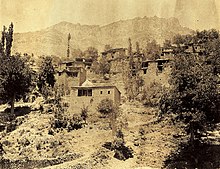
Although the Kurds and Assyrians were well-integrated with each other, Gaunt writes that this integration "led straight into a world marked by violence, raiding, the kidnapping and rape of women, hostage taking, cattle stealing, robbery, plundering, the torching of villages and a state of chronic unrest".[24]Assyrian efforts to maintain their autonomy collided with the Ottoman Empire's nineteenth-century attempts at centralization and modernization to assert control over what had effectively been astateless region.[25]The first mass violence targeting Assyrians was in the mid-1840s, when Kurdish emirBedir Khandevastated Hakkari and Tur Abdin,killing several thousands.[26][27]During intertribal feuds, the bulk of the violence was directed at Christian villages under the protection of the opposing tribe.[28]
During theRusso-Turkish War of 1877–1878,the Ottoman state armed the Kurds with modern weapons to fight Russia. When the Kurds refused to return the weapons at the end of the war, Assyrians—relying on older weapons—were at a disadvantage and subject to increasing violence.[29]The irregularHamidiyecavalry were formed in the 1880s from Kurdish tribes loyal to the government; their exemption from civil and military law enabled them to commit acts of violence with impunity.[28][30]
The rise ofpolitical Islamin the form of Kurdishshaikhsalso widened the divide between the Assyrians and the Muslim Kurds.[29]Many Assyrians were killed in the 1895massacres of Diyarbekir.[31]Violence worsened after the 1908Young Turk Revolution,despite Assyrian hopes that the new government would stop promoting anti-Christian Islamism.[32][33]In 1908, 12,000 Assyrians were expelled from theLizan valleyby the Kurdish emir ofBarwari.[34]Due to increasing Kurdish attacks which Ottoman authorities did nothing to prevent, Patriarch of the Church of the EastMar Shimun XIX Benyaminbegan negotiations with theRussian EmpirebeforeWorld War I.[17]
World War I
[edit]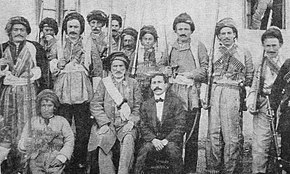
Before the war, Russia and the Ottoman Empire courted populations in each other's territory to wage guerrilla warfare behind enemy lines. The Ottoman Empire tried to enlistCaucasianMuslims and Armenians, as well as Assyrians andAzerisin Persia, and Russia looked to the Armenians, Kurds, and Assyrians living in the Ottoman Empire.[35]Prior to the war, Russia controlled parts of northeastern Persia, including Azerbaijan and Tabriz.[36][37]
Like other genocides, the Sayfo had a number of causes. Therise of nationalismled to competingTurkish,Kurdish,Persian,andArab national movements,which contributed to increasing violence in the already conflict-ridden borderlands inhabited by the Assyrians. HistorianDonald Bloxhamemphasizes the negative influence of European powers interfering in the Ottoman Empire under the premise of protecting Ottoman Christians. Thisimperialismput the Ottoman Christians at risk of retaliatory attacks. In 1912 and 1913, the Ottoman loss in theBalkan Warstriggered an exodus of Muslim refugees from the Balkans.[38]
TheCommittee of Union and Progress(CUP) government decided to resettle the refugees in eastern Anatolia, on land confiscated from populations deemed disloyal to the empire.[38]There was a direct connection between the deportation of the Christian population and the resettlement of Muslims in the depopulated areas.[39]The goals of the population replacement were toTurkifythe Balkan Muslims and end the perceived internal threat from the Christian populations. With local politicians predisposed to violence against non-Muslims, these factors helped generate the preconditions for genocide.[40]
CUP politicianEnver Pashaset up the paramilitarySpecial Organization,which was loyal to himself. Its members, many of whom were convicted criminals released from prison for the task, operated as spies and saboteurs.[41]The Ottoman Empire ordered a full mobilization for war on 24 July 1914, and concluded theGerman–Ottoman allianceshortly thereafter.[42]In August 1914, the CUP sent a delegation to anArmenian conferenceoffering an autonomous Armenian region if theArmenian Revolutionary Federationincited a pro-Ottoman revolt in Russia in the event of war.[43]
The Armenians refused. According to Gaunt, a similar offer was probably made to Mar Shimun inVanon 3 August. After returning to Qudshanis, Mar Shimun sent letters urging his followers to "fulfill strictly all their duties to the Turks".[43]The Assyrians in Hakkari (like many other Ottoman subjects) resisted conscription into the Ottoman army during the mobilization, and many fled to Persia in August.[44]Those inMardin,however, accepted conscription.[45]
Ethnic cleansing of Hakkari
[edit]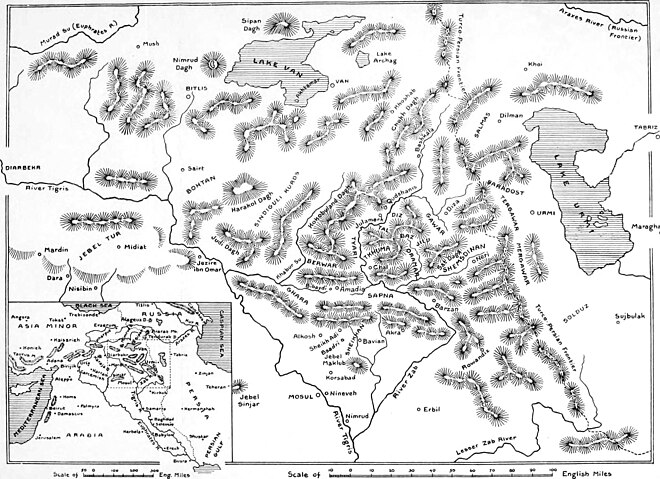
Massacres of lowland Assyrians
[edit]In August 1914, Assyrians in nine villages near the border were forced to flee to Persia and their villages were burned after they refused to join the Ottoman army.[46]On 26 October 1914, a few days before the Ottoman Empire entered World War I, Ottoman interior ministerTalaat Pashasent a telegram toDjevdet Bey,the governor ofVan province(which included Hakkari). In a planned Ottoman attack in Persia, the loyalty of the Hakkari Assyrians was doubted. Talaat ordered the deportation and resettlement of the Assyrians who lived near the Persian border with Muslims farther west. No more than twenty Assyrians would live in each resettlement, destroying their culture, language, and traditional way of life.[47][48][49]
Gaunt cites this order as the beginning of the Sayfo.[50]The government in Van reported that the order could not be implemented due to the lack of forces to carry it out, and by 5 November the expected Assyrian unrest did not materialize.[51]Assyrians inJulamerkandGawarwere arrested or killed, and Ottoman irregulars attacked Assyrian villages throughout Hakkari in retaliation for their refusal to follow the order.[50][49]The Assyrians, unaware of the government's role in these events until December 1914, protested to the governor of Van.[49]
The Ottoman garrison in the border town ofBashkalewas commanded byKazim Karabekir,and the local Special Organization branch byÖmer Naji.Russian forces captured Bashkale andSaraiin November 1914 and held both for a few days. After their recapture by the Ottomans, the towns' local Christians were punished as collaborators, out of proportion to any actual collaboration.[52][53]Local Ottoman forces consisting ofgendarmerie,Hamidiye irregulars, and Kurdish volunteers were unable to mount attacks on the Assyrian tribes on the highlands, confining their attacks to poorly-armed Christian villages in the plains. Refugees from the area told the Russian army that "nearly the entire male Christian population of Gawar and Bashkale" had been massacred.[54]In May 1915, Ottoman forces retreating from Bashkale massacred hundreds of Armenian women and children before continuing to Siirt.[55]
Preparations for war
[edit]Mar Shimun learned about the massacre of Assyrians in lowland areas, and believed that the highland tribes would be next. ViaAgha Petros,an Assyrian interpreter for the Russian consulate inUrmia,he contacted the Russian authorities. Shimun traveled to Bashkale to meetMehmed Shefik Bey,an Ottoman official sent from Mardin to win over the Assyrians for the Ottoman cause, in December 1914. Shefik promised protection and money in exchange for a written promise that the Assyrians would not side with Russia or permit their tribes to take up arms against the Ottoman government. The tribal chiefs considered the offer, but rejected it.[56]
In January 1915, Kurds blocked the route from Qudshanis to the Assyrian tribes. The patriarch's sister,Surma D'Bait Mar Shimun,left Qudshanis the following month with 300 men.[57]Early in 1915, the tribes of Hakkari were preparing to defend themselves from a large-scale attack; they decided to send women and children to the area around Chamba inUpper Tyari,leaving only combatants behind.[58]
On 10 May, the Assyrian tribes met and declared war (or a general mobilization) against the Ottoman Empire.[59]In June, Mar Shimun traveled to Persia to ask for Russian support. He met with GeneralFyodor ChernozubovinMoyanjik(in the Salmas valley), who promised support. The patriarch and Agha Petros also met Russian consulBasil Nikitinin Salmas shortly before 21 June, but the promised Russian help never materialized.[57]
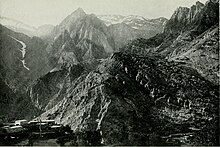
In May, Assyrian warriors were part of the Russian force which was rushed to relieve thedefense of Van;Haydar Bey,the governor of Mosul, was given the power to invade Hakkari. Talaat ordered him to drive the Assyrians out and added, "We should not let them return to their homelands".[60]The ethnic-cleansing operation was coordinated by Enver, Talaat, and military and civilian Ottoman authorities. To legalize the invasion, the districts of Julamerk, Gawar, andShemdinanwere temporarily transferred toMosul province.[61]The Ottoman army joined local Kurdish tribes against specific targets. Suto Agha of the KurdishOramar tribeattackedJilu,Dez,andBazfrom the east; Said Agha attacked a valley in Lower Tyari; Ismael Agha targeted Chamba in Upper Tyari, and the Upper Berwar emir attackedAshita,the Lizan valley, and Lower Tyari from the west.[55]
Invasion of the highlands
[edit]The joint encirclement operation was launched on 11 June.[55]The Jilu tribe was attacked at the beginning of the campaign by several Kurdish tribes; the fourth-century church ofMar Zaya,with historic artifacts, was destroyed. Ottoman forces based in Julamerk and Mosul launched a joint attack on Tyari on 23 June.[55][62]Haydar first attacked the Tyari villages of Ashita and Sarespido; later, an expeditionary force of three thousand Turks and Kurds attacked the mountain pass between Tyari andTkhuma.Although the Assyrians were victorious in most of the battles, they had unsustainable losses of lives and ammunition and lacked their invaders' German-manufactured rifles, machine guns, and artillery.[63]
In July, Mar Shimun sentMalik Khoshabaand bishop Mar Yalda Yahwallah from Barwari toTabrizin Persia to request urgent assistance from the Russians.[62]The KurdishBarzani tribeassisted the Ottoman army and laid waste to Tkhuma, Tyari, Jilu, and Baz.[64]During the campaign, Ottoman forces took no prisoners.[65]Mar Shimun's brother, Hormuz, was arrested while he was studying inConstantinople;in late June, Talaat tried to obtain the surrender of the Assyrian tribes by threatening Hormuz' life if Mar Shimun did not capitulate. The Assyrians refused, and he was killed.[66][67]
Outnumbered and outgunned, the Assyrians retreated further into the high mountains without food[68][64]and watched as their homes, farms, and herds were pillaged.[65]They had no other option but fleeing to Persia, which most had done by September. Most of the men joined the Russian army, hoping to return home.[64][69]During the 1915 fighting, the Assyrians' only strategic objective was defensive;[70]the Ottoman goal was to defeat the Assyrian tribes and prevent their return.[71]
Ottoman occupation of Azerbaijan
[edit]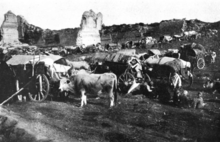
In 1903, Russia estimated that 31,700 Assyrians lived in Persia.[72]Facing attacks from their Kurdish neighbors, the Assyrian villages in the Ottoman–Persian borderlands organized self-defense forces; by the outbreak of World War I, they were well armed.[73][22]In 1914, before the declaration of war against Russia, Ottoman forces crossed the border into Persia and destroyed Christian villages. Large-scale attacks in late September and October 1914 targeted many Assyrian villages, and the attackers neared Urmia.[74]
Due to Ottoman attacks, thousands of Christians living along the border fled to Urmia.[75]Others arrived in Persia after fleeing from the Ottoman side of the border. TheNovember 1914 proclamation of jihadby the Ottoman government inflamedjihadistsentiments in the Ottoman–Persian border area, convincing the local Kurdish population to side with the Ottomans.[76]In November, Persia declared its neutrality; however, it was not respected by the warring parties.[73]
Russia organized units of Assyrian and Armenian volunteers to bolster local Russian forces against Ottoman attack.[77]Assyrians led by Agha Petros declared their support for theEntente,and marched in Urmia. Agha Petros later said that he had been promised by Russian officials that in exchange for their support, they would receive an independent state after the war.[78]Ottoman irregulars in Van province crossed the Persian border, attacking Christian villages in Persia.[79]
In response, Persia shut down the Ottoman consulates inKhoy,Tabriz, and Urmia and expelledSunni Muslims.Ottoman authorities retaliated with the expulsion of several thousand Hakkari Assyrians to Persia. Resettled in farming villages, the Assyrians were armed by Russia.[79]The Russian government was aware that the Assyrians and Armenians of Azerbaijan could not stop an Ottoman army, and was indifferent to the danger to which these communities would be exposed in an Ottoman invasion.[80]
On 1 January 1915, Russia abruptly withdrew its forces. Ottoman forces led by Djevdet, Kazim Karabekir, and Ömer Naji occupied Azerbaijan with no opposition.[81]Immediately after the withdrawal of Russian forces, local Muslims committed pogroms against Christians; the Ottoman army also attacked Christian civilians. Over a dozen villages were sacked and, of the large villages, onlyGulpashanwas left intact. News of the atrocities spread quickly, leading many Armenians and Assyrians to flee to the Russian Caucasus. Those north of Urmia had more time to flee.[82]According to several estimates, about 10,000[83]or 15,000 to 20,000 crossed the border into Russia.[84]Assyrians who had volunteered for the Russian forces were separated from their families, who were often left behind.[85]An estimated 15,000 Ottoman troops reached Urmia by 4 or 5 January, andDilmanon 8 January.[86][87]
Massacres
[edit]
Ottoman troops began attacking Christian villages during their February 1915 retreat, when they were turned back by a Russian counterattack.[88]Facing losses which they blamed on Armenian volunteers and imagining a broad Armenian rebellion, Djevdet ordered massacres of Christian civilians to reduce the potential future strength of volunteer units.[89]Some local Kurdish tribes participated in the killings, but others protected Christian civilians.[90]Some Assyrian villages also engaged in armed resistance when attacked.[86]The PersianMinistry of Foreign Affairsprotested the atrocities to the Ottoman government, but lacked the power to prevent them.[91][92]
Many Christians did not have time to flee during the Russian withdrawal,[93]and 20,000 to 25,000 refugees were stranded in Urmia.[91]Nearly 18,000 Christians sought shelter in the city's Presbyterian andLazaristmissions. Although there was reluctance to attack the missionary compounds, many died of disease.[94]Between February and May, when the Ottoman forces pulled out, there was a campaign of mass execution, looting, kidnapping, and extortion against Christians in Urmia.[91]More than 100 men were arrested at the Lazarist compound, and dozens, including Mar Dinkha, bishop of Tergawer, were executed on 23 and 24 February.[95]Near Urmia, the large Syriac village of Gulpashan was attacked; men were killed, and women and children were abducted and raped.[96][97]
There were no missionaries in the Salmas valley to protect Christians, although some local Muslims tried to do so. In Dilman, the Persian governor offered shelter to 400 Christians; he was forced to surrender the men to Ottoman forces, however, who executed them in the town square.[95]The Ottoman forces lured Christians toHaftevan,a village south of Dilman, by demanding that they register there, and arrested notable people in Dilman who were brought to the village for execution. Over two days in February, 700 to 800 people, including the entire male Christian population, was murdered in Haftevan. The killings were committed by the Ottoman army, led by Djevdet, and the localShekakKurdish tribe, led bySimko Shikak.[98][95]
In April, Ottoman army commanderHalil Pashaarrived in Azerbaijan with reinforcements fromRowanduz.Halil and Djevdet ordered the murder of Armenian and Syriac soldiers serving in the Ottoman army, and several hundred were killed.[99][100]In several other massacres in Azerbaijan in early 1915, hundreds of Christians were killed[101]and women were targeted for kidnapping and rape;[102][103]seventy villages were destroyed.[104]In May and June, Christians who had fled to the Caucasus returned to find their villages destroyed.[105]Armenian and Assyrian volunteers attacked Muslims in revenge.[106]After retreating from Persia, Ottoman forces—blaming Armenians and Assyrians for their defeat—took revenge against Ottoman Christians.[91]Ottoman atrocities in Persia were widely covered by international media in mid-March 1915, prompting adeclarationon 24 May by Russia, France, and the United Kingdom condemning them.[89][107]TheBlue Book,a collection of eyewitness reports of Ottoman atrocities published by the British government in 1916, devoted 104 of its 684 pages to the Assyrians.[108]
Butcher battalion in Bitlis
[edit]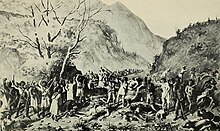
AKurdish rebellionin Bitlis province was suppressed shortly before the outbreak of war in November 1914. The CUP government reversed its previous opposition to the Hamidiye regiments, recruiting them to put down the rebellion.[109][110]As elsewhere, military requisitions became pillage;[109][111]in February, labor-battalion recruits began to disappear.[112]In July and August 1915, 2,000 Chaldeans and Syriac Orthodox from Bitlis were among those who fled to the Caucasus when the Russian army retreated from Van.[113]

Before the war, Siirt and the surrounding area were Christian enclaves populated largely by Chaldean Catholics.[114]Catholic priestJacques Rhétoréestimated that there were 60,000 Christians living in the Siirt district (sanjak), including 15,000 Chaldeans and 20,000 Syriac Orthodox.[115]Violence in Siirt began on 9 June with the arrest and execution of Armenian, Syriac Orthodox, and Chaldean clerics and notable residents, including the Chaldean bishopAddai Sher.[116][117]
After retreating from Persia, Djevdet led the siege of Van; he continued to Bitlis province in June with 8,000 soldiers, whom he called the "butcher battalion" (Turkish:kassablar taburu).[118]The arrival of these troops in Siirt led to more violence.[117]District governor (mutasarrif) Serfiçeli Hilmi Bey and Siirt mayor Abdul Ressak were replaced because they did not support the killing.[119][120]Forty local officials in Siirt organized the massacres.[116]
During the month-long massacre, Christians were killed in the streets or their houses (which were looted).[115]TheChaldean diocese of Siirtwas destroyed, including its library of rare manuscripts.[121]The massacre was organized by Bitlis governorAbdülhalik Renda,the chief of police, the mayor, and other prominent local residents.[122]The killing in Siirt was committed byçetes,and the surrounding villages were destroyed by Kurds;[115]many local Kurdish tribes were involved.[123]According to Venezuelan mercenaryRafael de Nogales,the massacre was planned as revenge for Ottoman defeats by Russia.[115]De Nogales believed that Halil was trying to assassinate him, since the CUP had disposed of other witnesses. He left Siirt as quickly as he could, passing deportation columns of Syriac and Armenian women and children.[124]
Only 400 people were deported from Siirt; the remainder were killed or kidnapped by Muslims.[117]The deportees (women and children, since the men had been executed) were forced to march west from Siirt towards Mardin or south towards Mosul, assaulted by police.[119][125]As they passed through, their possessions, including their clothes, were stolen by local Kurds and Turks. Those unable to keep up were killed. Women considered attractive were abducted by police or Kurds, raped, and killed.[126]One site of attacks and robbery by Kurds was the gorge of Wadi Wawela inSawrokaza,northeast of Mardin.[127]No deportees reached Mardin,[119]and only 50[119][117]to 100 Chaldeans (of an original 7,000 to 8,000) reached Mosul.[128]Three Assyrian villages in Siirt—Dentas, Piroze andHertevin—survived the Sayfo, existing until 1968 when their residents emigrated.[129]
After leaving Siirt, Djevdet proceeded toBitlisand arrived on 25 June. His forces killed men, and the women and girls were enslaved by Turks and Kurds.[119][130]The Syriac Orthodox Church estimated its Bitlis province losses at 8,500, primarily inSchirwanand Gharzan.[131]
Diyarbekir
[edit]The situation for Christians in Diyarbekir province worsened during the winter of 1914–1915; the Saint Ephraim church was vandalized, and four young men from the Syriac village ofQarabash(nearDiyarbekir) were hanged for desertion. Syriacs who protested the executions were clubbed by police, and two died.[132][133]In March, many non-Muslim soldiers were disarmed and transferred to road-building labor battalions. Harsh conditions, mistreatment, and individual murders led to many deaths.[134]
On 25 March, CUP founding memberMehmed Reshidwas appointed governor of Diyarbekir.[135][136]Chosen for his record of anti-Armenian violence,[137]Reshid brought thirty Special Organization members (mainlyCircassians) who were joined by released convicts.[135]Many local officials (kaymakamsand district governors) refused to follow Reshid's orders, and were replaced in May and June 1915.[138]Kurdish confederations were offered rewards to allow their Syriac clients to be killed.[139][140]Government allies complied (including theMilliandDekşuri), and many who had supported the anti-CUP1914 Bedirhan revoltswitched sides because the extermination of Christians did not threaten their interests.[139][141]TheRaman tribebecame enthusiastic executioners for Reshid, but parts of theHeverkanleadership protected Christians; this limited Reshid's genocide, and allowed pockets of resistance to survive in Tur Abdin. SomeYazidis,who were also persecuted by the government, aided the Christians.[141]The killers in Diyarbekir were typically volunteers organized by local leaders, and the freelance perpetrators took a share of the loot.[142]Some women and children were abducted into local Kurdish or Arab families.[143]
Thousands of Armenians and several hundred Syriacs (including all their clergymen) in Diyarbekir city were arrested, deported, and massacred in June.[144]In theViranşehirkaza, west of Mardin, its Armenians were massacred in late May and June 1915. Syriacs were not killed, but many lost their property and some were deported to Mardin in August.[145]In total, 178 Syriac towns and villages near Diyarbekir were wiped out and most of them razed.[146]
Targeting of non-Armenian Christians
[edit]Under Reshid's leadership, a systematic anti-Christian extermination was conducted in Diyarbekir province which included Syriacs and the province's fewGreek OrthodoxandGreek Catholics.[147][148]Reshid knew that his decision to extend the persecution to all Christians in Diyarbekir was against the central government's wishes, and he concealed relevant information from his communications.[149]Unlike the government, Reshid and his Mardin deputy Bedri Bey classified all Aramaic-speaking Christians as Armenians: enemies of the CUP who must be eliminated.[150]Reshid planned to replace Diyarbekir's Christians with selected, approved Muslim settlers to counterbalance the potentially-rebellious Kurds; in practice, however, the areas were resettled by Kurds and the genocide consolidated the province's Kurdish presence.[151]HistorianUğur Ümit Üngörsays that in Diyarbekir, "most instances of massacre in which the militia engaged were directly ordered by" Reshid and "all Christian communities of Diyarbekir were equally hit by the genocide, although the Armenians were often particularly singled out for immediate destruction".[152]The priest Jacques Rhétoré estimated that the Syriac Orthodox in Diyarbekir province lost 72 percent of their population, compared to 92 percent ofArmenian Catholicsand 97 percent ofArmenian Apostolic Churchadherents.[153]
German diplomats noticed that the Ottoman deportations were targeting groups other than Armenians, leading to a complaint from the German government.[154][155]Austria-Hungaryand theHoly Seealso protested the violence against non-Armenians.[156]Talaat Pasha telegraphed Reshid on 12 July 1915 that "measures adopted against the Armenians are absolutely not to be extended to other Christians... you are ordered to put an immediate end to these acts ".[156][157]No action was taken against Reshid for exterminating Syriac Christians or assassinating Ottoman officials who disagreed with the massacres, however, and in 1916 he was appointed governor of Ankara. Talaat's telegram may have been sent in response to German and Austrian opposition to the massacres, with no expectation of implementation.[156][157]The perpetrators began separating Armenians and Syriacs in early July, only killing the former;[158][159]however, the killing of Syriacs resumed in August and September.[160]
Mardin district
[edit]
Christians in Mardin were largely untouched until May 1915.[148]At the end of May, they heard about the abduction of Christian women and the murder of wealthy Christians elsewhere in Diyarbekir to steal their property. Extortion and violence began in Mardin district, despite the efforts of district governorHilmi Bey.[161]Hilmi rejected Reshid's demands to arrest Christians in Mardin, saying that they posed no threat to the state.[148][162]Reshid sentPirinççizâde Aziz Feyzito incite anti-Christian violence in April and May, and Feyzi bribed or persuaded the Deşi, Mışkiye, Kiki and Helecan chieftains to join him.[148][163]Mardin police chief Memduh Bey arrested dozens of men in early June, using torture to extract confessions of treason and disloyalty and extorting money from their families. Reshid appointed a new mayor and officials in Mardin, who organized a 500-man militia to kill.[148][164]He also urged the central government to depose Hilmi, which it did on 8 June.[165][166]He was replaced by the equally-resistant Shefik, whom Reshid also tried to depose.[167][168]The cooperative Ibrahim Bedri was appointed as an official and Reshid used him to carry out his orders, bypassing Shefik.[167][169]Reshid also replaced Midyat governor Nuri Bey with the hardline Edib Bey in July 1915, after Nuri refused to cooperate with Reshid.[170]
On the night of 26 May, militiamen were caught attempting to plant arms in a Syriac Catholic church in Mardin. Their intent was to cite the supposed discovery of an arms cache as evidence of a Christian rebellion to justify the planned massacres.[171]Mardin's well-to-do Christians were deported in convoys, the first of which left the city on 10 June. Those who refused to convert to Islam were murdered on the road to Diyarbekir. Half of the second convoy, which departed on 12 June, had been massacred before messengers from Diyarbekir announced that the non-Armenians had been pardoned by the sultan; they were subsequently freed.[172]Other convoys from Mardin were targeted for extermination from late June until October.[173]The city's Syriac Orthodox made a deal with authorities and were spared, but the other Christian denominations were decimated.[174][175]
All Christian denominations were treated the same in the Mardin district countryside.[176]Militia and Kurds attacked the village ofTell Ermenon 1 July, killing men, women, and children indiscriminately in the church after raping the women.[177]The next day, more than 1,000 Syriac Orthodox and Catholics were massacred inEqsorby militia and Kurds from the Milli, Deşi, Mişkiye, and Helecan tribes. Looting continued for several days before the village was burned down (which could be seen from Mardin).[175][178]InNusaybin,Talaat's order to spare the Syriacs was ignored as Christians of all denominations (including many Syriac Orthodox Church members) were arrested in mid-August and murdered in a ravine.[179][180]InDjezire(Cizre)kaza,Syriac Orthodox leader Gabro Khaddo cooperated with the authorities, defused plans for armed resistance, and paid a large ransom in June 1915;[181]almost all Syriacs were killed with thekaza'sArmenians at the end of August.[179][180]Some Armenian and Syriac Orthodox men were drafted to work in road construction or harvesting crops in place of those who had been killed. In August 1915, the harvest was over; the Armenians were killed, and the Syriacs were released.[182]
Tur Abdin
[edit]
InTur Abdin,some Syriac Christians fought their attempted extermination.[183][184]This was considered treason by Ottoman officials,[184]who reported massacre victims as rebels.[185]Christians inMidyatconsidered resistance after hearing about massacres elsewhere, but the local Syriac Orthodox community initially refused to support this.[186]On 21 June, 100 men (mostly Armenians and Protestants) were arrested, tortured for confessions implicating others, and executed outside the city; this panicked the Syriac Orthodox.[187][176]Local people refused to hand over their arms, attacked government offices, and cuttelegraphlines; local Arab and Kurdish tribes were recruited to attack the Christians.[187]The town was pacified in early August after weeks of bloodyurban warfarewhich killed hundreds of Christians.[188][184]Survivors fled east to the more-defensibleIwardo,whichheld out successfullywith the food aid of local Yazidis.[184][189]
In June 1915, many Syriacs from Midyatkazawere massacred; others fled to the hills.[190]A month earlier, local tribes and the Ramans began attacking Christian villages near Azakh (present-dayİdil) on the road from Midyat to Djezire. Survivors fled to Azakh, since it was defensible.[191][192]The villages were attacked from north to south, giving the attackers at Azakh (one of the southernmost villages) more time to prepare.[193]The primarily Syriac Orthodox village refused to hand over Catholics and Protestants, as demanded by the authorities. Azakh was first attacked on 17[192]or 18 August, but the defendersrepelled this and subsequent attacksover the next three weeks.[192][193]
Against the advice of GeneralMahmud Kâmil Pasha,Enver ordered the rebellion suppressed in November.[191]Parts of theThird,Fourth,andSixthArmies and a Turkish–German expeditionary force underMax Erwin von Scheubner-Richterand Ömer Naji were sent to crush the rebels, the latter diverted from attackingTabriz.[194]To justify the attack on Azakh, Ottoman officials claimed (with no evidence) that Armenian rebels had "cruelly massacred the Muslim population of the region".[194][195]Scheubner, skeptical of the attack, forbade any Germans from participating.[194][196]German generalColmar Freiherr von der Goltzand the German ambassador in Constantinople,Konstantin von Neurath,informed ChancellorTheobald von Bethmann Hollwegof the Ottoman request for German assistance in crushing the resistance. The Germans refused, fearing that the Ottomans would insinuate that the Germans initiated the anti-Christian atrocities.[197][198]The defenders launched a surprise attack on Ottoman troops during the night of 13–14 November, which led to a truce (lobbied by the Germans) which ended the resistance on favorable terms for the villagers.[199][200]On 25 December 1915, the Ottoman government decreed that "instead of deporting all of the Syriac people", they were to be confined "in their present locations".[201]Most of Tur Abdin was in ruins by this time, except for villages which resisted and families who found refuge in monasteries.[157]Other Syriacs had fled south, into present-day Syria and Iraq.[202]
Aftermath
[edit]Ethnic violence in Azerbaijan
[edit]| External image | |
|---|---|
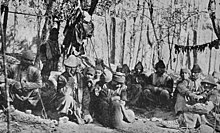
After their expulsion from Hakkari, the Assyrians and their herds were resettled by Russian occupation authorities near Khoy, Salmas and Urmia.[69][203]Many died during the first winter due to lack of food, shelter, and medical care,[204]and they were resented by local residents for worsening living standards.[69][203]Assyrian men from Hakkari offered their services to the Russian military; although their knowledge of local terrain was useful, they were poorly disciplined.[205]In 1917, Russia's withdrawal from the war after theRussian Revolutiondimmed prospects of a return to Hakkari.[69][203]About 5,000 Assyrian[206]and Armenian militia policed the area, but they frequently abused their power and killed Muslims without provocation.[207]
From February to July 1918, the region was engulfed by ethnic violence.[208][209]On 22 February, local Muslims and the Persian governor began an uprising against the Christian militias in Urmia. The better-organized Christians, led by Agha Petros, brutally crushed the uprising; hundreds (possibly thousands) were killed.[207]On 16 March, Mar Shimun and many of his bodyguards were killed by the Kurdish chieftainSimko Shikak,probably at the instigation of Persian officials fearing Assyrian separatism, after they met to discuss an alliance. Assyrians went on a killing and looting spree; unable to find Simko, they murdered Persian officials and inhabitants.[210][211]The Kurds responded by massacring Christians, regardless of denomination or ethnicity.[209]Christians were massacred in Salmas in June and in Urmia in early July,[208]and many Assyrian women were abducted.[102]
Christian militias in Azerbaijan were no match for the Ottoman army when it invaded in July 1918.[207]Tens of thousands of Ottoman and Persian Assyrians fled south toHamadan,where the BritishDunsterforcewas garrisoned, on 18 July to escape Ottoman forces approaching Urmia underAli İhsan Sâbis.[212][213]The Ottoman invasion was followed by killings of Christians, including Chaldean archbishopToma Audo,and the sacking of Urmia.[214][209]Some remained in Persia, but there was another anti-Christian massacre on 24 May 1919.[209][208]Historian Florence Hellot-Bellier says that the interethnic violence of 1918 and 1919 "demonstrate[s] the degree of violence and resentment which had accumulated throughout all of these years of war and the break-up of the long-standing links between the inhabitants of the Urmia region".[62]According to Gaunt, Assyrian "victims, when given the chance, turned without hesitation into perpetrators".[215]
Exile in Iraq
[edit]

During the journey to Hamadan, the Assyrians were harassed by Kurdish irregulars[216](probably at the instigation of Simko andSayyid Taha);[214]some died of exhaustion. Many were killed nearHeydarabad,and another 5,000 during an ambush by Ottoman forces and Kurdish irregulars near theSahin Ghal'emountain pass.[216]Dependent on the British for protection, they were resettled in a refugee camp inBaqubah(near Baghdad) which held fifteen thousand Armenians and thirty-five thousand Assyrians in October 1918.[209][217]Conditions at the camp were poor, and an estimated 7,000 Assyrians died there.[209]Although the United Kingdom requested that Assyrian refugees be allowed to return, the Persian government refused.[209]
In 1920, the camp in Baqubah was shut down and Assyrians hoping to return to Azerbaijan or Hakkari were sent northwards to Midan. About 4,500 Assyrians were resettled nearDuhokandAkrein northern Iraq.[218]They worked as soldiers for the British rulers ofMandatory Iraq,which backfired when the British did not follow through with their repeated promises to resettle Assyrians in areas where they would be safer. After the end of the mandate, Assyrians were killed in the 1933Simele massacre.[219]After the massacre, France allowed 24,000 to 25,000 Assyrians to resettle along theKhaburin northeastern Syria.[220]Other Assyrians were exiled in theCaucasus,Russia,orLebanon,and a few immigrated to theUnited States,Canada,South America,andEurope.[221]
Assyrians in Turkey
[edit]A few thousand Assyrians remained in Hakkari after 1915, and others returned after the war.[222]Armed by the British, Agha Petros led a group of Assyrians from Tyari and Tkhuma who wanted to return in 1920; he was repulsed by Barwari chieftain Rashid Bek and the Turkish army.[218][223][224]The remaining Assyrians were driven out again in 1924 by a Turkish army commanded by Kazim Karabekir, and the mountains were depopulated.[69][222]In Siirt, Islamicized Syriacs (primarily women) were left behind. TheirKurdified(orArabized) descendants still live there.[225]
The survivors lost access to their property, becoming landless agricultural laborers, or later, an urban underclass. The depopulated Christian villages were resettled by Kurds or Muslims from the Caucasus.[226]During and after the genocide, more than 150 churches and monasteries were demolished. Others were converted to mosques or other uses. Many manuscripts and cultural objects were destroyed.[227][228]
After 1923, local politicians went on an anti-Christian campaign which negatively impacted the Syriac communities (such asAdana,UrfaorAdiyaman) unaffected by the 1915 genocide. Many were forced to abandon their property and flee to Syria, eventually settling inAleppo,Qamishli,or the Khabur region.[229]Despite its effort to court the Turkish nationalists, including denying that Syriac Orthodox had been persecuted during the war, the Syriac Orthodox patriarchate was expelled from Turkey in 1924.[229][146]Unlike the Armenians, Jews, and Greeks, Assyrians were not recognized as a minority group in the 1923Treaty of Lausanne.[230]
The remaining population lived in submission to Kurdishaghas,subject to harassment and abuse which drove them to emigrate.[231][230]Turkish lawsdenaturalizedthose who had fled and confiscated their property. Despite their citizenship rights, many Assyrians who remained in Turkey had to re-purchase their property from Kurdish aghas or risk losing their Turkish citizenship.[231]A substantial number of Assyrians continued to live in Tur Abdin until the 1980s.[232]Some scholars have described the ongoing exclusion and harassment of Assyrians in Turkey as a continuation of the Sayfo.[233]
Paris Peace Conference
[edit]
In 1919, AssyriansattendedtheParis Peace Conferenceand attempted to lobby for compensation for their war losses. Although it has been labeled "the Assyrian delegation" in historiography, it was neither an official delegation nor a cohesive entity.[234]Many attendees demanded monetary reparations for their war losses and an independent state, and all emphasized that Assyrians could not live under Muslim rule.[235]Territory claimed by the Assyrians included parts of present-day Turkey, Iraq, and Iran.[236]
Although there was considerable sympathy for the Assyrians, none of their demands were met.[237]The British and the French had other plans for the Middle East, and the risingTurkish nationalist movementwas also an obstacle.[238][239]The Assyrians recalled that the British had promised them an independent country in exchange for their support, although it is disputed if such a promise was ever made;[207][240][241]many Assyrians felt betrayed that this desire was not fulfilled.[40]
Death toll
[edit]Assyrian delegates at the Paris Peace Conference said that their losses were 250,000 in the Ottoman Empire and Persia, around half of the prewar population. In 1923, at theLausanne Conference,they raised their estimate to 275,000. The source of these numbers is unknown and, according to Gaunt, their accuracy has been impossible to verify and the Assyrian delegation had an incentive to exaggerate.[242]Although more than 50 percent of the population was killed in some areas, Assyrian communities in present-day Syria and Iraq were left mainly intact.[243][244]The Sayfo was less systematic than theArmenian genocide;all Christians were killed in some places, but local officials spared Assyrians and targeted Armenians in others.[245][246]
| Region | Losses | Notes |
|---|---|---|
| Persia | 40,000 | Gaunt says that this number is probably an overestimate, and there is no reliable figure.[209]According to historianDonald Bloxham,"perhaps 7,000 Persian Assyrians" were killed in 1915.[248]A German observer estimated that 21,000 Christians were killed inAzerbaijanbetween December 1914 and February 1915.[103] |
| Van(including Hakkari) | 80,000 | According to Gaunt, "This is a very high figure and should be treated with caution".[249]Russian consulBasil Nikitinestimated that 45,000 Assyrians from Hakkari fled to Persia, out of more than 70,000 prewar residents.[250] |
| Diyarbekir | 63,000 | Catholic priestJacques Rhétoréestimated that 60,725 Syriac Orthodox, 10,010 Chaldeans, 3,450 Syriac Catholics, and 500 Protestants were killed, of 144,185 total Christian deaths in Diyarbekir. British Army officerEdward Noelestimated 96,000 Syriac Orthodox, 7,000 Chaldeans, 2,000 Syriac Catholics, and 1,200 Protestants out of 157,000 Christian deaths.[251] |
| Harput | 15,000 | According to historianRaymond Kévorkian,Assyrians were spared from deportation from Harput;[252]Gaunt says that the Armenian genocide in Harput became a Christian one.[69] |
| Bitlis | 38,000 | Rhétoré estimated that before the war, 60,000 Christians lived inSiirt district(including 15,000 Chaldeans and 20,000 Syriac Orthodox).[115]The Syriac Orthodox Church estimated its losses at 8,500 in the province.[131] |
| Adana,Der Zorand elsewhere | 5,000 | Gaunt lists Adana as a place where the Assyrian population was untouched by the Sayfo.[229] |
| Urfa | 9,000 | Gaunt also lists Urfa as a place where the Assyrian population was not affected by the Sayfo.[229] |
| Total | 250,000 | — |
Legacy
[edit]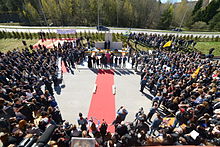
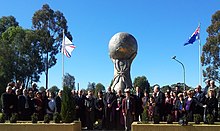
For Assyrians, the Sayfo is considered the greatest modern example oftheir persecution.[253]Eyewitness accounts of the genocide were typically passed down orally, rather than in writing;[254]memories were often passed down in lamentations.[255]After large-scale migration to Western countries (where Assyrians had greaterfreedom of speech) during the second half of the twentieth century, accounts began to be communicated more publicly by grandchildren of survivors.[256]
International recognition
[edit]The Sayfo is less well known than theArmenian genocide,[257]partially because its targets were divided among mutually-antagonistic churches and did not develop a collective identity.[258]During the 1990s, before the first academic research on the Sayfo, Assyrian diaspora groups (inspired by campaigns forArmenian genocide recognition) began to press for a similar formal acknowledgement.[259][260]In parallel with the political campaign, Armenian genocide research began to include Assyrians as victims.[261]In December 2007, theInternational Association of Genocide Scholarspassed a resolution recognizing the Assyrian genocide.[262][253][263]The Sayfo is also recognized as a genocide in resolutions passed by Sweden (in 2010),[264][265]Armenia (2015),[266][267]the Netherlands (2015),[268]and Germany (in 2016).[268][269]Memorials in Armenia, Australia, Belgium, France, Greece, Sweden, Ukraine, and the United States commemorate victims of the Sayfo.[270]
Denial and justification
[edit]The Turkish government denies that the Sayfo was a genocide; unlike itsdenial of the Armenian genocide,however, it prefers to avoid the issue.[271][272]After the 1915 genocide, the Turkish government initially silenced its discussion inhigh cultureand written works.[254]Non-Turkish music and poetry were suppressed, and the Syriac Orthodox Church discouraged discussion of the Sayfo for fear of reprisals from the Turkish government.[273]
Those attempting tojustifythe destruction of Assyrian communities in the Ottoman Empire cite military resistance by some Assyrians against the Ottoman government. According to Gaunt et al., "Under no circumstances are states allowed to annihilate an entire population simply because it refuses to comply with a hostile government order to vacate their ancestral homes".[274]Assyrian idealization of their military leaders, including those who committed war crimes against Muslims, has also been cited as a reason why all Assyrians deserved their fate.[215]
In 2000, Turkish Syriac Orthodox priest Yusuf Akbulut was secretly recorded saying: "At that time it was not only the Armenians but also the Assyrians [Süryani] who were massacred on the grounds that they were Christians". The recording was given to Turkish prosecutors, who charged Akbulut with inciting ethnic hatred.[275][276]Assyrian diaspora activists mobilized in support of Akbulut, persuading several European members of parliament to attend his trial; after more than a year, he was acquitted and released.[264]
Turkish Australians interviewed by researcher Adriaan Wolvaardt had identical attitudes towards the Sayfo and the Armenian genocide, rejecting both as unfounded.[277]Wolvaardt wrote that bringing up the Sayfo was "viewed as a form of hate directed against Turks",[278]some of whom had considered leaving the Sydney suburb of Fairfield after a Sayfo memorial was built there.[278]
References
[edit]Citations
[edit]- ^Wozniak 2012,p. 73.
- ^Murre-van den Berg 2018,p. 770.
- ^Gaunt 2010,p. 9,passim.
- ^Murre-van den Berg 2018,p. 777.
- ^Gaunt 2010,pp. 12–14.
- ^abGaunt 2015,p. 86.
- ^Talay 2017,pp. 132, 136.
- ^abGauntet al.2017,p. 7.
- ^Gauntet al.2017,p. 17.
- ^Gauntet al.2017,p. 18.
- ^abGauntet al.2017,pp. 18–19.
- ^Suny 2015,p. 48.
- ^Gaunt 2013,p. 318.
- ^abGaunt 2020,p. 57.
- ^Gaunt 2020,p. 60.
- ^Tamcke 2009,pp. 203–204.
- ^abcdGaunt 2015,p. 87.
- ^Üngör 2011,p. 13.
- ^Üngör 2011,p. 15.
- ^Gauntet al.2017,p. 19.
- ^abGaunt 2020,p. 58.
- ^abGaunt 2020,p. 59.
- ^abGaunt 2015,pp. 86–87.
- ^Gaunt 2017,p. 64.
- ^Gaunt 2020,pp. 57, 59.
- ^Gauntet al.2017,pp. 2, 20.
- ^Gaunt 2017,p. 59.
- ^abGaunt 2017,pp. 59, 61.
- ^abGaunt 2017,pp. 60–61.
- ^Gauntet al.2017,p. 20.
- ^Gauntet al.2017,p. 2.
- ^Gaunt 2013,pp. 323–324.
- ^Gaunt 2017,pp. 63–64.
- ^Gaunt 2011,p. 323.
- ^Gaunt 2006,p. 56.
- ^Gaunt 2006,p. 85.
- ^Hellot-Bellier 2018,pp. 110, 112–113.
- ^abGaunt 2015,pp. 97–98.
- ^Yalcin 2009,p. 217.
- ^abGaunt 2015,p. 98.
- ^Gaunt 2006,p. 58.
- ^Üngör 2011,p. 56.
- ^abGaunt 2006,pp. 56–57.
- ^Gaunt 2006,p. 127.
- ^Gaunt 2006,p. 310.
- ^Gaunt 2011,pp. 247–248.
- ^Gaunt 2006,pp. 128–129.
- ^Suny 2015,p. 234.
- ^abcGaunt 2011,p. 248.
- ^abGaunt 2020,p. 70.
- ^Kaiser, Hilmar(17–18 April 2008)."A Deportation that Did Not Occur"(PDF).Armenian Weekly.Archived(PDF)from the original on 17 May 2021.Retrieved27 June2021.
- ^Gaunt 2006,p. 130.
- ^Gaunt 2011,p. 251.
- ^Gaunt 2006,pp. 136–137.
- ^abcdGaunt 2011,p. 257.
- ^Gaunt 2006,p. 137.
- ^abHellot-Bellier 2018,p. 128.
- ^Gaunt 2006,p. 138.
- ^Gaunt 2006,pp. 123, 140.
- ^Gaunt 2015,pp. 93–94.
- ^Gaunt 2006,p. 142.
- ^abcHellot-Bellier 2018,p. 129.
- ^Gaunt 2006,pp. 142–143.
- ^abcGaunt 2006,p. 144.
- ^abGaunt 2006,p. 312.
- ^Gaunt 2006,pp. 143–144.
- ^Gaunt 2011,pp. 257–258.
- ^Gaunt 2015,pp. 88–89.
- ^abcdefGaunt 2015,p. 94.
- ^Gaunt 2006,pp. 122, 300.
- ^Gaunt 2011,p. 259.
- ^Gaunt 2020,p. 73.
- ^abHellot-Bellier 2018,p. 112.
- ^Gaunt 2006,p. 129.
- ^Hellot-Bellier 2018,pp. 117, 125.
- ^Gaunt 2011,p. 250.
- ^Gaunt 2011,p. 249.
- ^Hellot-Bellier 2018,pp. 117–118.
- ^abGaunt 2006,pp. 129–130.
- ^Bloxham 2005,p. 74.
- ^Gaunt 2006,pp. 60–61.
- ^Gaunt 2011,p. 252.
- ^Kévorkian 2011,p. 226.
- ^Hellot-Bellier 2018,pp. 119–120.
- ^Gaunt 2006,p. 103.
- ^abGaunt 2006,pp. 103–104.
- ^Hellot-Bellier 2018,p. 119.
- ^Gaunt 2006,p. 105.
- ^abGaunt 2006,p. 106.
- ^Hellot-Bellier 2018,pp. 120–121.
- ^abcdGaunt 2006,p. 110.
- ^Gaunt 2011,pp. 253–254.
- ^Hellot-Bellier 2018,p. 120.
- ^Hellot-Bellier 2018,p. 122.
- ^abcHellot-Bellier 2018,p. 126.
- ^Gaunt 2011,p. 254.
- ^Naby 2017,p. 165.
- ^Gaunt 2006,pp. 81, 83–84.
- ^Gaunt 2006,pp. 108–109.
- ^Gaunt 2011,p. 255.
- ^Hellot-Bellier 2018,pp. 121–122.
- ^abNaby 2017,p. 167.
- ^abKévorkian 2011,p. 227.
- ^Hofmann 2018,p. 30.
- ^Hellot-Bellier 2018,p. 127.
- ^Gaunt 2006,pp. 84, 104–105.
- ^Gaunt 2015,p. 93.
- ^Yacoub 2016,pp. 67–68.
- ^abKévorkian 2011,p. 234.
- ^Gaunt 2006,p. 37.
- ^Polatel 2019,pp. 129–130.
- ^Kévorkian 2011,p. 237.
- ^Yacoub 2016,p. 54.
- ^Gaunt 2006,p. 250.
- ^abcdeGaunt 2006,p. 251.
- ^abKévorkian 2011,p. 339.
- ^abcdPolatel 2019,p. 132.
- ^Gaunt 2006,pp. 89, 251, 254.
- ^abcdeKévorkian 2011,p. 340.
- ^Gaunt 2006,pp. 254–255.
- ^Yacoub 2016,pp. xiii, 116–117, 168.
- ^Gaunt 2006,p. 255.
- ^Gaunt 2006,p. 256.
- ^Kévorkian 2011,pp. 338–339.
- ^Gaunt 2006,p. 253.
- ^Yuhanon 2018,pp. 204–205.
- ^Yuhanon 2018,pp. 206–207.
- ^Gaunt 2006,p. 252.
- ^Yacoub 2016,p. 198.
- ^Yacoub 2016,pp. 132–133.
- ^abYacoub 2016,p. 136.
- ^Üngör 2011,p. 60.
- ^Gaunt 2006,pp. 154–155.
- ^Üngör 2011,pp. 60–61.
- ^abÜngör 2011,p. 61.
- ^Gaunt 2006,p. 155.
- ^Gaunt 2006,pp. 153, 155.
- ^Kévorkian 2011,pp. 362–363.
- ^abGaunt 2017,pp. 65–66.
- ^Kaiser 2014,p. 420.
- ^abKaiser 2014,p. 419.
- ^Kaiser 2014,pp. 422–423.
- ^Kaiser 2014,p. 323.
- ^Kévorkian 2011,pp. 363–364.
- ^Kévorkian 2011,p. 366.
- ^abGaunt 2011,p. 327.
- ^Üngör 2011,p. 97.
- ^abcdeÜngör 2017,p. 35.
- ^Kaiser 2014,pp. 424–425.
- ^Kaiser 2014,pp. 345–346.
- ^Kaiser 2014,pp. 425–426.
- ^Üngör 2011,p. 99.
- ^Gaunt 2017,p. 65.
- ^Gaunt 2020,pp. 83–84.
- ^Üngör 2011,p. 92.
- ^abcKévorkian 2011,p. 379.
- ^abcGaunt 2015,p. 96.
- ^Üngör 2017,pp. 45–46.
- ^Kaiser 2014,p. 322.
- ^Gaunt 2020,p. 84.
- ^Kaiser 2014,p. 314.
- ^Kaiser 2014,pp. 309–311.
- ^Kaiser 2014,pp. 313–314.
- ^Kaiser 2014,pp. 316–317.
- ^Üngör 2017,pp. 35–36.
- ^Kaiser 2014,p. 316.
- ^abÜngör 2017,p. 36.
- ^Kaiser 2014,p. 320.
- ^Kaiser 2014,pp. 421–422, 429.
- ^Kaiser 2014,pp. 290, 334–335.
- ^Kévorkian 2011,p. 372.
- ^Üngör 2017,pp. 36–38.
- ^Üngör 2017,pp. 38–39.
- ^Gaunt 2015,p. 85.
- ^abKévorkian 2011,p. 373.
- ^abKévorkian 2011,p. 376.
- ^Üngör 2017,p. 39.
- ^Üngör 2017,pp. 39–40.
- ^abÜngör 2017,pp. 47–48.
- ^abKévorkian 2011,p. 378.
- ^Kaiser 2014,pp. 338–339.
- ^Kaiser 2014,p. 324.
- ^Gaunt 2015,p. 89.
- ^abcdGaunt 2020,p. 85.
- ^Kaiser 2014,p. 331.
- ^Kaiser 2014,p. 332.
- ^abKaiser 2014,p. 333.
- ^Kaiser 2014,pp. 329–331, 333–334.
- ^Kaiser 2014,p. 334.
- ^Kévorkian 2011,pp. 376–377.
- ^abGaunt 2015,pp. 89–90.
- ^abcKaiser 2014,p. 337.
- ^abGaunt 2015,p. 90.
- ^abcKévorkian 2011,p. 377.
- ^Kaiser 2014,p. 340.
- ^Gaunt 2020,p. 91.
- ^Gaunt 2015,p. 91.
- ^Kaiser 2014,pp. 343–345.
- ^Kaiser 2014,pp. 340–342.
- ^Gaunt 2015,pp. 91–92.
- ^Gaunt 2015,pp. 90, 95.
- ^Gaunt 2020,p. 87.
- ^abcHellot 2003,p. 138.
- ^Gaunt 2006,p. 122.
- ^Gaunt 2020,pp. 77–78.
- ^Koohi-Kamali 2003,p. 76.
- ^abcdGaunt 2020,p. 78.
- ^abcHellot 2003,pp. 138–139.
- ^abcdefghGaunt 2020,p. 80.
- ^Koohi-Kamali 2003,pp. 76–77.
- ^Gaunt 2020,p. 79.
- ^Hellot-Bellier 2020,17.
- ^Kévorkian 2011,p. 744.
- ^abKoohi-Kamali 2003,p. 77.
- ^abGaunt 2020,p. 77.
- ^abKévorkian 2011,pp. 744–745.
- ^Hellot 2003,p. 139.
- ^abHellot 2003,p. 142.
- ^Gaunt 2020,pp. 80–81.
- ^Hellot-Bellier 2020,36.
- ^Yacoub 2018,17.
- ^abGaunt 2020,p. 72.
- ^Gaunt 2020,p. 81.
- ^Hellot-Bellier 2020,27.
- ^Altuğ 2021,pp. 88–89.
- ^Altuğ 2021,pp. 89–90.
- ^Talay 2018,p. 8.
- ^Yacoub 2018,13.
- ^abcdGaunt 2020,p. 88.
- ^abBiner 2019,p. xv.
- ^abBiner 2011,p. 371.
- ^Gaunt 2020,p. 69.
- ^Biner 2019,pp. 14–15.
- ^Lundgren 2021,pp. 63–64, 66.
- ^Lundgren 2021,pp. 67–68.
- ^Hellot-Bellier 2020,18.
- ^Lundgren 2021,pp. 69–70.
- ^Lundgren 2021,p. 71.
- ^Hellot-Bellier 2020,23.
- ^Hellot-Bellier 2020,15–16.
- ^Müller-Sommerfeld 2016,p. 270.
- ^Gaunt 2015,pp. 88, 96.
- ^Gaunt 2015,pp. 96–97.
- ^Murre-van den Berg 2018,p. 776.
- ^Murre-van den Berg 2018,p. 775.
- ^Üngör 2017,p. 49.
- ^Gaunt 2006,p. 300.
- ^Bloxham 2005,p. 98.
- ^Gaunt 2020,p. 71.
- ^Hellot-Bellier 2018,pp. 109, 129.
- ^Üngör 2011,p. 85.
- ^Kévorkian 2011,pp. 390, 394, 415.
- ^abAtto 2016,p. 184.
- ^abAtto 2016,p. 185.
- ^Atto 2016,pp. 192–193.
- ^Atto 2016,pp. 194–195.
- ^Kieser & Bloxham 2014,p. 585.
- ^Gaunt 2013,p. 317.
- ^Gaunt 2015,pp. 94–95.
- ^Gauntet al.2017,pp. 7–8.
- ^Koinova 2019,p. 1900.
- ^Gauntet al.2017,p. 8.
- ^Sjöberg 2016,p. 197.
- ^abBiner 2011,p. 375.
- ^Sjöberg 2016,pp. 202–203.
- ^Sjöberg 2016,p. 215.
- ^Talay 2018,p. 13.
- ^abKoinova 2019,p. 1901.
- ^Yacoub 2018,3.
- ^Yacoub 2016,p. 211.
- ^Talay 2018,pp. 14–15.
- ^Koinova 2019,p. 1897.
- ^Atto 2016,pp. 184, 186.
- ^Gauntet al.2017,p. 23.
- ^Donef 2017,pp. 210–211.
- ^Biner 2011,pp. 374–375.
- ^Wolvaardt 2014,p. 118.
- ^abWolvaardt 2014,p. 121.
Sources
[edit]Books
[edit]- Biner, Zerrin Özlem (2019).States of Dispossession: Violence and Precarious Coexistence in Southeast Turkey.University of Pennsylvania Press.ISBN978-0-8122-9659-4.
- Bloxham, Donald(2005).The Great Game of Genocide: Imperialism, Nationalism, and the Destruction of the Ottoman Armenians.Oxford University Press.ISBN978-0-19-927356-0.
- Gaunt, David(2006).Massacres, Resistance, Protectors: Muslim-Christian Relations in Eastern Anatolia During World War I.Gorgias Press.ISBN978-1-59333-301-0.
- Kaiser, Hilmar(2014).The Extermination of Armenians in the Diarbekir Region.İstanbul Bilgi University Press.ISBN978-605-399-333-9.
- Kévorkian, Raymond(2011).The Armenian Genocide: A Complete History.Bloomsbury Publishing.ISBN978-0-85771-930-0.
- Koohi-Kamali, Farideh (2003).The Political Development of the Kurds in Iran: Pastoral Nationalism.Palgrave Macmillan UK.ISBN978-0-230-53572-5.
- Sjöberg, Erik(2016).The Making of the Greek Genocide: Contested Memories of the Ottoman Greek Catastrophe.Berghahn Books.ISBN978-1-78533-326-2.
- Suny, Ronald Grigor(2015)."They Can Live in the Desert but Nowhere Else": A History of the Armenian Genocide.Princeton University Press.ISBN978-1-4008-6558-1.
- Üngör, Uğur Ümit(2011).The Making of Modern Turkey: Nation and State in Eastern Anatolia, 1913–1950.Oxford University Press.ISBN978-0-19-965522-9.
- Yacoub, Joseph(2016).Year of the Sword: The Assyrian Christian Genocide: A History.Hurst.ISBN978-0-19-063346-2.
Chapters
[edit]- Altuğ, Seda (2021). "Culture of Dispossession in the Late Ottoman Empire and Early Turkish Republic".Reverberations: Violence Across Time and Space.University of Pennsylvania Press.pp. 83–116.ISBN978-0-8122-9812-3.
- Donef, Racho (2017). "Sayfo and Denialism: A New Field of Activity for Agents of the Turkish Republic".Let Them Not Return: Sayfo – The Genocide Against the Assyrian, Syriac, and Chaldean Christians in the Ottoman Empire.Berghahn Books.pp. 205–218.ISBN978-1-78533-499-3.
- Gaunt, David; Atto, Naures; Barthoma, Soner O. (2017). "Introduction: Contextualizing the Sayfo in the First World War".Let Them Not Return: Sayfo – The Genocide Against the Assyrian, Syriac, and Chaldean Christians in the Ottoman Empire.Berghahn Books.pp. 1–32.ISBN978-1-78533-499-3.
- Gaunt, David (2011). "The Ottoman Treatment of the Assyrians".A Question of Genocide: Armenians and Turks at the End of the Ottoman Empire.Oxford University Press.pp. 245–259.ISBN978-0-19-978104-1.
- Gaunt, David (2013). "Failed Identity and the Assyrian Genocide".Shatterzone of Empires: Coexistence and Violence in the German, Habsburg, Russian, and Ottoman Borderlands(illustrated ed.).Indiana University Press.pp. 317–333.ISBN978-0-253-00631-8.
- Gaunt, David (2017). "Sayfo Genocide: The Culmination of an Anatolian Culture of Violence".Let Them Not Return: Sayfo – The Genocide Against the Assyrian, Syriac, and Chaldean Christians in the Ottoman Empire.Berghahn Books.pp. 54–69.ISBN978-1-78533-499-3.
- Gaunt, David (2020). "The Long Assyrian Genocide".Collective and State Violence in Turkey: The Construction of a National Identity from Empire to Nation-State.Berghahn Books.pp. 56–96.ISBN978-1-78920-451-3.
- Hellot, Florence (2003). "La fin d'un monde: les assyro-chaldéens et la première guerre mondiale" [The end of a world: the Assyro-Chaldeans and the First World War].Chrétiens du monde arabe: un archipel en terre d'Islam[Christians of the Arab world: an archipelago in the land of Islam] (in French). Autrement. pp. 127–145.ISBN978-2-7467-0390-2.
- Hellot-Bellier, Florence (2018). "The Increasing Violence and the Resistance of Assyrians in Urmia and Hakkari (1900–1915)".Sayfo 1915: An Anthology of Essays on the Genocide of Assyrians/Arameans during the First World War.Gorgias Press.pp. 107–134.ISBN978-1-4632-0730-4.
- Hofmann, Tessa(2018). "The Ottoman Genocide of 1914–1918 against Aramaic-Speaking Christians in Comparative Perspective".Sayfo 1915: An Anthology of Essays on the Genocide of Assyrians/Arameans during the First World War.Gorgias Press.pp. 21–40.ISBN978-1-4632-0730-4.
- Kieser, Hans-Lukas;Bloxham, Donald (2014). "Genocide".The Cambridge History of the First World War:Volume 1: Global War.Cambridge University Press.pp. 585–614.ISBN978-0-511-67566-9.
- Müller-Sommerfeld, Hannah (2016)."The League of Nations, A-Mandates and Minority Rights during the Mandate Period in Iraq (1920–1932)".Modernity, Minority, and the Public Sphere.Brill.pp. 258–283.ISBN978-90-04-32328-5.Archivedfrom the original on 10 February 2022.Retrieved10 February2022.
- Murre-van den Berg, Heleen(2018). "Syriac Identity in the Modern Era".The Syriac World.Routledge.pp. 770–782.ISBN978-1-317-48211-6.
- Naby, Eden(2017). "Abduction, Rape and Genocide: Urmia's Assyrian Girls and Women".The Assyrian Genocide: Cultural and Political Legacies.Routledge.pp. 158–177.ISBN978-1-138-28405-0.
- Polatel, Mehmet (2019). "The State, Local Actors and Mass Violence in Bitlis Province".The End of the Ottomans: The Genocide of 1915 and the Politics of Turkish Nationalism.Bloomsbury Academic.pp. 119–140.ISBN978-1-78831-241-7.
- Talay, Shabo (2017). "Sayfo, Firman, Qafle: The First World War from the Perspective of Syriac Christians".Let Them Not Return: Sayfo – The Genocide Against the Assyrian, Syriac, and Chaldean Christians in the Ottoman Empire.Berghahn Books.pp. 132–147.ISBN978-1-78533-499-3.
- Talay, Shabo (2018). "Sayfo 1915: the Beginning of the End of Syriac Christianity in the Middle East".Sayfo 1915: An Anthology of Essays on the Genocide of Assyrians/Arameans during the First World War.Gorgias Press.pp. 1–20.ISBN978-1-4632-3996-1.
- Tamcke, Martin (2009). "World War I and the Assyrians".The Christian Heritage of Iraq: Collected papers from the Christianity of Iraq I-V Seminar Days.Gorgias Press.pp. 203–220.ISBN978-1-4632-1713-6.
- Üngör, Uğur Ümit (2017). "How Armenian was the 1915 Genocide?".Let Them Not Return: Sayfo – The Genocide Against the Assyrian, Syriac, and Chaldean Christians in the Ottoman Empire.Berghahn Books.pp. 33–53.ISBN978-1-78533-499-3.
- Wolvaardt, Adriaan (2014). "Inclusion and Exclusion: Diasporic Activism and Minority Groups".Muslim Citizens in the West: Spaces and Agents of Inclusion and Exclusion.Ashgate Publishing.pp. 105–124.ISBN978-0-7546-7783-3.
- Wozniak, Marta (2012). "Far from Aram-Nahrin: The Suryoye Diaspora Experience".Border Terrains: World Diasporas in the 21st Century.Brill.pp. 73–83.ISBN978-1-84888-117-4.
- Yalcin, Zeki (2009). "The Turkish Genocide against Christian Minorities during WW1 from the Perspective of Contemporary Scandinavian Observers".Suryoye l-Suryoye: Ausgewählte Beiträge zur aramäischen Sprache, Geschichte und Kultur[Suryoye l-Suryoye: Selected Contributions to Aramaic Language, History and Culture].Gorgias Press.pp. 213–228.ISBN978-1-4632-1660-3.
- Yuhanon, B. Beth (2018). "The Methods of Killing Used in the Assyrian Genocide".Sayfo 1915: An Anthology of Essays on the Genocide of Assyrians/Arameans during the First World War.Gorgias Press.pp. 177–214.ISBN978-1-4632-3996-1.
Journal articles
[edit]- Atto, Naures (2016). "What Could Not Be Written: A Study of the Oral Transmission of Sayfo Genocide Memory Among Assyrians".Genocide Studies International.10(2): 183–209.doi:10.3138/gsi.10.2.04.
- Biner, Zerrin Özlem (2011). "Multiple imaginations of the state: understanding a mobile conflict about justice and accountability from the perspective of Assyrian–Syriac communities".Citizenship Studies.15(3–4): 367–379.doi:10.1080/13621025.2011.564789.
- Gaunt, David (4 October 2010)."Identity conflicts among Oriental Christian in Sweden".Sens public.Archivedfrom the original on 10 February 2022.Retrieved10 February2022.
- Gaunt, David (2015)."The Complexity of the Assyrian Genocide".Genocide Studies International.9(1): 83–103.doi:10.3138/gsi.9.1.05.ISSN2291-1847.
- Hellot-Bellier, Florence (2020)."Les relations ambiguës de la France et des Assyro-Chaldéens dans l'histoire. Les mirages de la" protection ""[The ambiguous relations of France and the Assyro-Chaldeans in history. The mirages of "protection" ].Les Cahiers d'EMAM(in French) (32).doi:10.4000/emam.2912.ISSN1969-248X.Archivedfrom the original on 8 May 2020.Retrieved13 March2021.
- Koinova, Maria (2019)."Diaspora coalition-building for genocide recognition: Armenians, Assyrians and Kurds"(PDF).Ethnic and Racial Studies.42(11): 1890–1910.doi:10.1080/01419870.2019.1572908.Archived(PDF)from the original on 3 March 2022.Retrieved19 February2022.
- Lundgren, Svante (2021)."Why did the Assyrian lobbying at the Paris Peace Conference fail?".Chronos.41:63–73.doi:10.31377/chr.v41i.689(inactive 12 September 2024).ISSN1608-7526.Archivedfrom the original on 22 January 2022.Retrieved22 January2022.
{{cite journal}}:CS1 maint: DOI inactive as of September 2024 (link) - Yacoub, Joseph(2018). "Longtemps méconnu par la communauté internationale: le génocide assyro-chaldéen de 1915" [Long ignored by the international community: the Assyro-Chaldean genocide of 1915].Relations Internationales(in French).173(1): 45–64.doi:10.3917/ri.173.0045.
Further reading
[edit]- Akdemir, Mary (2023). "Big Secrets, Small Villages: The Collective Memory of the Assyrian Genocide".The Genocide of the Christian Populations in the Ottoman Empire and its Aftermath (1908-1923).Taylor & Francis.ISBN978-1-000-83361-4.
- Gaunt, David (2023). "Late Recognition of the Assyrian Genocide".The Genocide of the Christian Populations in the Ottoman Empire and its Aftermath (1908-1923).Taylor & Francis.ISBN978-1-000-83361-4.
- Lundgren, Svante (2023). "When the Assyrian Tragedy Became Seyfo: A Study of Swedish-Assyrian Politics of Memory".Genocide Studies International.14(2): 95–108.doi:10.3138/GSI-2022-0002.S2CID257178308.
- Assyrian genocide
- Ethnic cleansing in Asia
- Diyarbekir vilayet
- Van vilayet
- History of West Azerbaijan province
- World War I crimes by the Ottoman Empire
- Massacres of Christians
- Persecution of Assyrians
- Persecution of Christians in the Ottoman Empire
- Massacres in the Ottoman Empire
- Mass murder in 1915
- Persecution by Muslims
- History of the Assyrians
- Turkish nationalism
- Persecution of Assyrians in the Ottoman Empire



